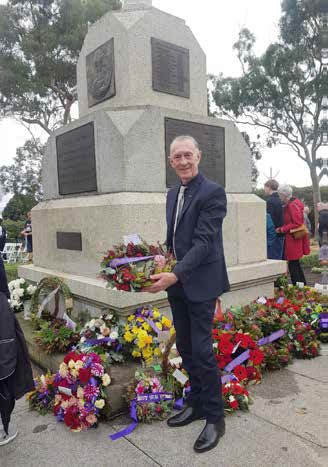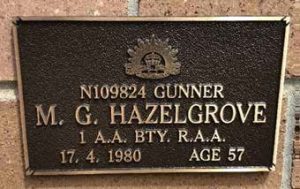MEMORIAL NEWS
Australian War Memorial, Canberra—1 July 2025

Brian Adams, grandson of Harry Adams who was
aboard the Montevideo Maru, laying a wreath for
Anzac Day at Memorial Park, Mornington—
hosted by the Mornington RSL, Victoria
The Last Post Ceremony at the AWM will commemorate George Christopher Harrington NX191465 and the 83rd anniversary of the sinking of the Montevideo Maru.
All are welcome to share this service of reflection. The service commences at 4.30 pm. Tickets are free but are required to attend. You are encouraged to register in advance although tickets may be available at Memorial entry providing there is capacity available. If you would like to attend please let admin@montevideo-maru.org know.
On 23 March 2025 Milton Alfred Warner of 2/22nd was also honoured at the Last Post Ceremony at the AWM.
Montevideo Maru Service, Brisbane—1 July 2025
The annual Montevideo Maru Memorial Service, held by NGVR/PNGVR Ex-members Association, for those 1,053 lost Australians, military and civilian internees, on the MS Montevideo Maru in 1942 will be held in the Memorial Galleries located under the Brisbane Cenotaph at 10 am, 1 July 2025. Anzac Day dress with medals as appropriate. Everyone welcome, please arrive by 9.45 am. Morning tea will follow the service. Enquiries to admin@montevideo-maru.org.
ANZAC Day
Thank you to Kylie Adams-Collier for representing the Rabaul & Montevideo Maru group at Pittwater RSL’s Dawn Service and laying a wreath on our behalf.
Rabaul and Montevideo Maru Website—Education Program
The Education program on the Rabaul and Montevideo Maru website has been recently upgraded. The link is https://montevideo-maru.org/education/
Included are lesson plans, background notes, worksheets, links, resources, templates and easy access to an electronic 15-minute version of the video Some Came Home, all to be used in conjunction or separately to support the delivery of this unit of work.
Also included is a link to the notes, classroom worksheets and writing ideas for Finding Darcy by Sue Lawson, one of the books recommended in the Premier’s Reading Challenge booklists for both South Australia and Western Australia.
A section of Poems and Songs has also been added. Please share these links with family and friends, and help this association by contacting and suggesting your lower-secondary schools consider using it. If they are interested, please also let us know at education@montevideo-maru.org
NSW History Curriculum update
The new NSW History Curriculum, to be implemented in 2027, will mean that a new topic, titled Australians At War, combining WWI history and WWII history, will be compulsory in year 9. Combining these histories together makes sense as they have connections. At the moment this history has been taught in two different years. War history in PNG flows from WWI to WWII, though it would surprise many students and some teachers that Australians were fighting in New Guinea during WWI!
Letters from Rabaul 1942
On 28 April 1942 Japanese bombers dropped mail bags with about 100 letters in each over Port Moresby, and 395 letters from Australian prisoners-of-war in Rabaul are recorded as having been dropped out of the sky. Why did the Japanese deliver these letters? Nothing had been heard of the prisoners since the invasion and occupation on 23 January 1942 and these were the only letter some families received. Other families received nothing.
A month after the letter drop an article in the Melbourne Argus is titled ‘Meagre News in Letters from Rabaul’. Excerpts include:
‘the Japanese are going to great trouble to see that we have the privilege of writing this note’.
‘Please do not worry about me as I am alright. Let us hope and pray that it will only be a short time before we are all together again.’
‘I’ve said more prayers than ever in my life. Tell Marie these beads she brought me are nearly worn out.’
‘No need to worry. We are being well looked after.’
The letters were optimistic—they were censored first by the Japanese and then by the Australians. In late October 1945 families were sent telegrams saying that the men ‘became missing on 1 July 1942 and were, for official purposes, presumed dead’.
Shot for Spying
Although there is the evidence of fair treatment to the prisoners in Rabaul there was one shocking event which would appear to go against this theory. Those of you who have read Ian Townsend’s book, Line of Fire, will know that in April 1942 the Japanese Army brought in a number of civilian prisoners to Rabaul including a child, who were all later executed. In his memoirs, Lark Force officer David Hutchinson Smith wrote:
Early in April we were shocked to see Mr and Mrs AA Harvey, their small son, aged about eight, Mrs Harvey’s brother, JS Mason, and a friend, W Parker, all of […] Plantation, Lassul Bay, brought into camp. We knew that they had been in hiding in the bush and were endeavouring to contact Moresby by teleradio for evacuation. The Japanese herded them in a small room opposite the guard house and only allowed them out only to have ulcers dressed or to visit the benjo, and then only under close guard. They were not supposed to speak to anyone, but the lad was allowed out now and then and played ball with guards, with whom he was apparently a favourite.
After about a week, the men were charged with espionage and were not permitted any legal representation. They were found ‘guilty’ and all five left camp with no belongings one afternoon and were never seen subsequently. The following day O’hara, a so-called ‘Christian’ submarine sailor, told us that they had all been shot, including the boy.
Note: A handwritten memoir of James MacKnight Hamilton who was escaping Rabaul, says he was advised of a teleradio and abundant food at Lassul, so he went to investigate. He wrote:
We met at Lassul homestead the most excitable, eccentric, drug addicted owner, Mr. Harvey, who was on the veranda, where most people in the tropics live, having breakfast about 1000 hours. He rushed down almost hysterical talking the whole time brought us onto the veranda and offered us breakfast … Harvey told us he had plenty of food to feed 200 for six months mostly hidden in dumps through the bush; his teleradio was packed up ready to move into the jungle and another man was down working on a boat. Every few minutes he would take a pill of some drug and every hour or so his wife (?), who could not get a word in edgewise, gave him a shot of some drug. … When he first got his teleradio he had an emergency frequency and code, but the first thing he did was code a long message to Port Moresby ordering more beer for Christmas from Burns Philp and Co, so they took away his codes and emergency frequency crystal.
On the 18th May 1942, the whole family, including Ted Harvey and his wife Marjorie Manson, her brother, Jimmy Manson and friend Bill Parker, were loaded on the back of a truck and driven a short journey from the prison camp to an isolated location in Rabaul, Young Richard, ‘Dickie’, stood between his mother and Ted Harvey, at the foot of a volcano, blindfolded to disguise the open pit. Dickie was 11 years and 3 months old.
Rod Miller
Max ‘Smacker’ Hazelgrove
George ‘Smacker’ Maxwell Hazelgrove, the son of George Hazelgrove and Amalia, née Whiffen, was born on 24 October 1923 in Bega, NSW. Max enlisted in the Australian Imperial Force (AIF) as Maxwell Hazelgrove N109824 in Sydney on 2 May 1941, claiming his age as 18 years and six months, making his date of birth as 27 October 1922. Max was a carpenter before becoming a gunner with the 1st Anti-Aircraft Brigade and a member of the Rabaul Anti-Aircraft Battery, a part of Lark Force. He arrived in Rabaul on 16 August 1941.
Max spent some time in hospital with malaria but was able to take part in the anti-aircraft defence of Rabaul. The Bega District News of Thursday, 8 January 1942 reported that ‘five Bega boys are in the anti-aircraft garrison at Rabaul, New Guinea, which was twice bombed by the Japanese on Sunday last. The boys are Pat Salway, Arthur Cooper, Bob Alexander, ‘Smacker’ Hazelgrove, son of Mr and Mrs G Hazelgrove, and Tom Alcock, who at one time worked in the Bega Co-operative store.’
We know from official army records and Japanese Prisoner of War (POW) records that these young Bega men, except for Max ‘Smacker’ Hazelgrove, died when the MS Montevideo Maru, a Japanese POW transport ship, was sunk by an American submarine on 1 July 1942. What happened to Smacker Hazelgrove?

Maxwell George Hazelgrove’s commemorative
plaque in the NSW Garden of Remembrance, a
memorial site adjacent to the Sydney War Cemetery,
within the Rookwood Necropolis (Photo courtesy of
The Office of Australian War Graves)
An examination of Max ‘Smacker’ Hazelgrove’s army service records reveals that he arrived in Sydney on 27 April 1942 for hospital treatment with a gunshot wound to his right shoulder. Max was discharged as medically unfit on 20 October 1942. There is no record in his army service records that he was a POW.
Max ‘Smacker’ Hazelgrove died in Sydney on 17 April 1980 aged 57. His full army service file is now freely available online through the National Archives of Australia using a Name Search. In his army service file, there is evidence that towards the end of 1970 he had contacted the Commonwealth Department of Repatriation (now the Commonwealth Department of Veterans’ Affairs) in Sydney, applying for Repatriation benefits. On 1 December 1970 the Department wrote to the Central Army Records Office in Melbourne stating they had information that he was a POW and asked the army to confirm whether this was correct. In a letter to the Commonwealth Department of Repatriation dated 9 December 1970, the Army Records Office stated that they had no record of Maxwell Hazelgrove being a POW. When the Department of Veterans’ Affairs compiled their WWII Nominal Roll, they used his army service records. Of course, Maxwell Hazelgrove was not noted as a POW.
A letter in Max’s file written during 1991 by his brother, Raymond, asks about the service of his late brother. Ray Hazelgrove, also a WWII veteran (NX204969), had gone to Rabaul after the war’s end to work in the War Graves Maintenance Unit for the Australian Army. Ray Hazelgrove had included a copy of the Official History of WWII (Wigmore), The Japanese Thrust, Ordeal of New Britain, p.667, with his letter. On this page Max Hazelgrove’s capture and his attempted execution by the Japanese armed forces at Tol Plantation was described. This was solid evidence that Max ‘Smacker’ Hazelgrove was an ex-POW.
With this information, I contacted the Commonwealth Department of Veterans Affairs and asked them to update their records for Maxwell Hazelgrove on the WWII Nominal Roll. This has been done and Max ‘Smacker’ Hazelgrove is now listed as a POW on the WWII Nominal Roll.
I also contacted The Office of the Australian War Graves, as all Australian ex-POWs are entitled to a commemoration from the Australian Government upon their death. A commemorative plaque for Maxwell Hazelgrove has now been erected by the Office of Australian War Graves in the NSW Garden of Remembrance, Rookwood, Sydney.
Sources:
Australian War Memorial, The Loss of Lark Force, Extracted from AWM website that fits with this report that Hazelgrove arrived in Australia with a gunshot wound on April 27, 1942. Available online at https://www.awm.gov.au/articles/blog/the-loss-of-lark-force
Commonwealth Department of Veterans’ Affairs websites for the WW2 Nominal Roll & Commemorations.
National Archives of Australia websites for Montevideo Maru and the Service Records Files for Maxwell Hazelgrove and Raymond Hazelgrove;
National Library of Australia’s TROVE website for The Bega District News newspaper; and NSW Registry of Births, Deaths and Marriages.
Patrick Bourke


